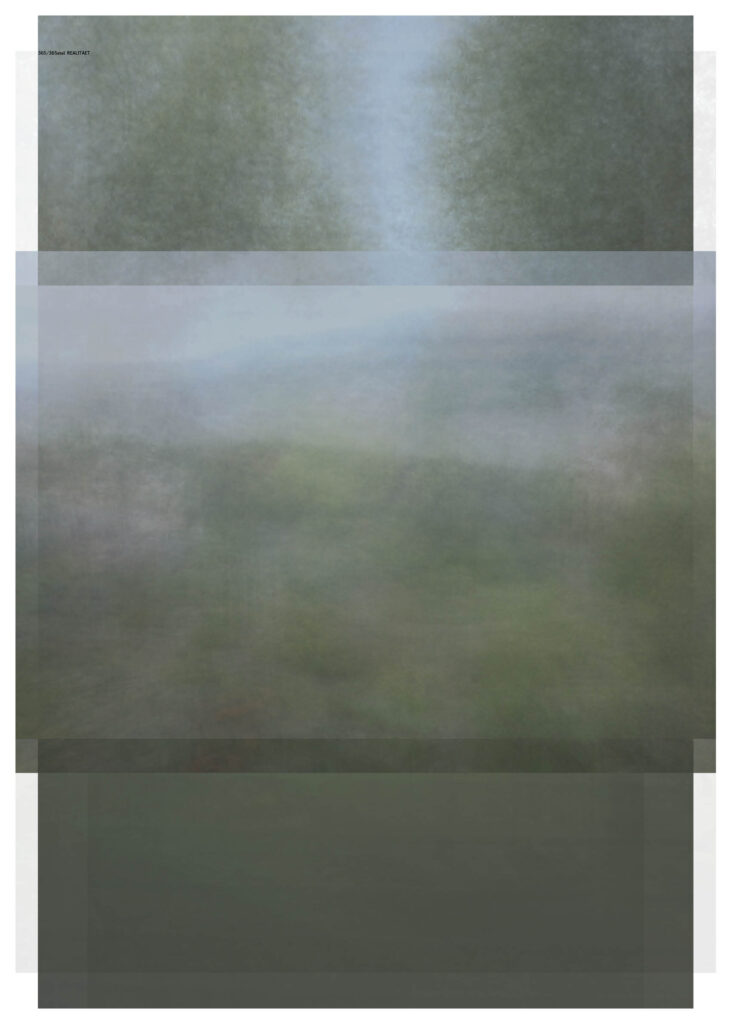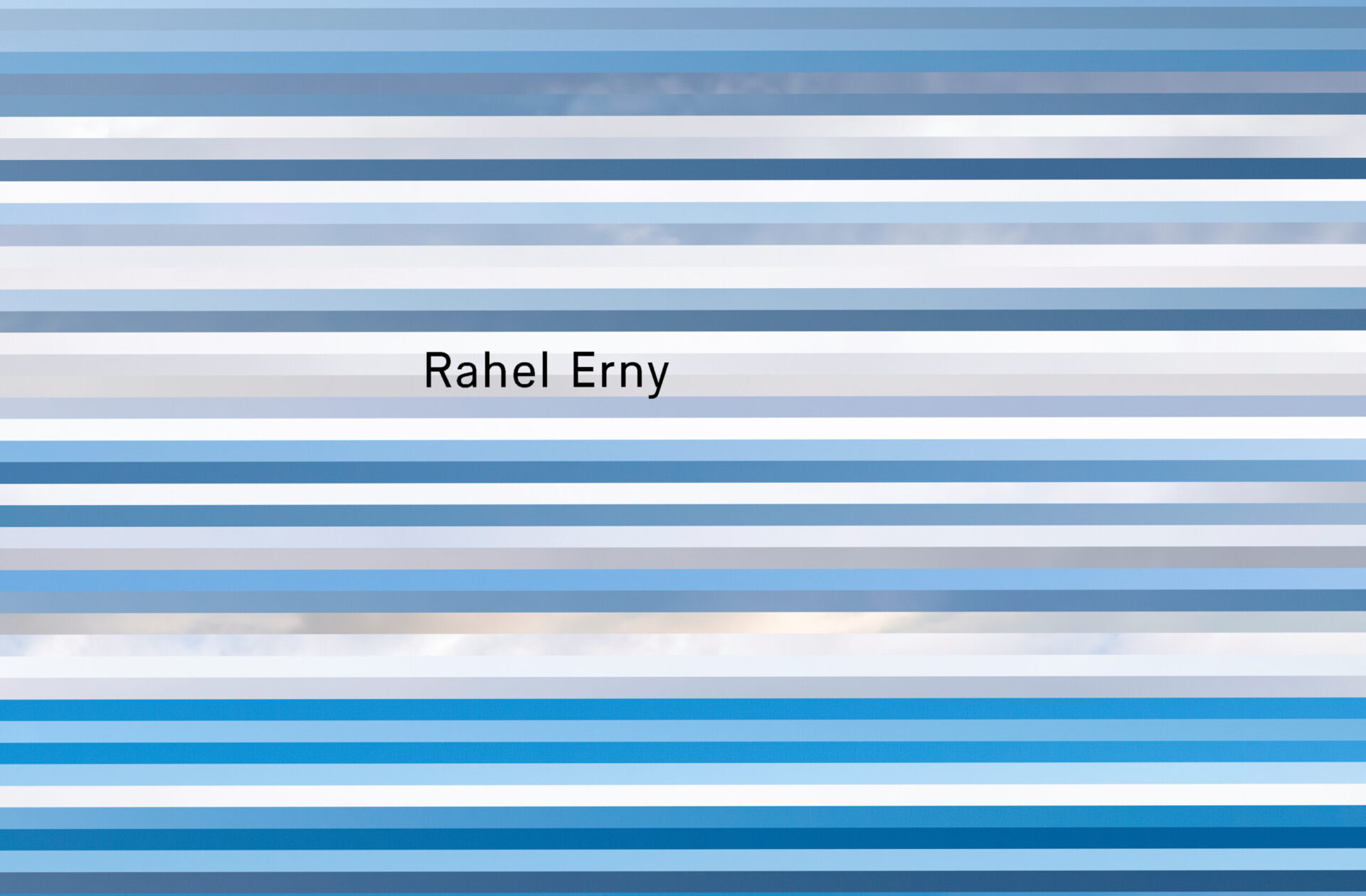translation from:
https://www.artlog.net/de/kunstbulletin-12-2014/ansichten-i-do-not-wish-add-any-more
Views – I do not wish to add any more
Switzerland in particular, but Hong Kong too, Paris, the Maldives in the summer – any and all of these locations could be contained in the whirring of the accompanying image. In other words: this layered image is composed of 365 photographs, each with 1/365th transparency.
According to Jean-Yves Jouannais in his Artistes sans oeuvres, the main function of Jorge Luis Borges’s texts is to save room on library shelves: “The more he writes,” says Jouannais, “the more he saves.” If Borges’s The Book of Sand is the book of books, then this image is the picture of pictures – a layered image that is for me a fitting response to a paraphrase of Douglas Huebler’s famous statement: “The world is full of pictures, more or less interesting, I do not wish to add any more.”
I often ask myself what happens to the multitude of photographs taken every day; how many billions of binary code combinations are stored, and where, and who has the time to look at them. But maybe most of the images produced today are not really meant to be viewed after the fact. I recall the image of a man who, aboard a cruise ship on the Rhine, viewed the entire landscape through his iPad: he seemed only to be able to see the images gliding by on the screen – a representation of the landscape, not the landscape itself.
Contrary to this contemporary overflow of images, the photograph here demonstrates not only a Borgesian way with images, it also proposes an original perspective: the image is made of the elemental acts of standing up and looking out the window. Here, it is the act of seeing that is documented, as opposed to replaced, by the act of recording images.
Every day for a year, the first glance outside, the first view-ing was recorded. Serendipity, it seems to me, is a fitting word for the result of this process. The repeated attempt to come closer to the outside world through the process of viewing has allowed a whirring to emerge, which reflects the blurriness of our reality. Or the other way around: the constructed image makes visible the fact that the whirring of reality is constructed not only out of what happens, but also from the way what happens is perceived, recorded, stored and remembered.
I encountered this image by Rahel Erny at “Schwindel der Wirklichkeit” (Vertigo of reality) at the Akademie der Künste in Berlin, a project featuring ZHdK masters in transdisciplinarity, in the fall of 2014. Delphine Chapuis Schmitz is an artist and works as an artistic research associate for the masters program in transdisciplinarity at the Zurich University of the Arts (ZHdK). delphinecs@yahoo.com

rahelerny.ch
Deutsch
Ansichten – I do not wish to add any more
Vor allem die Schweiz, aber auch Hongkong, Paris, die Malediven im Sommer – das Rauschen des nebenstehenden Bildes könnte gut alle diese Orte enthalten. Mit anderen Worten: 365 Fotografien mit je 1/365stel Transparenz bilden das Grundmaterial des geschichteten Bildes.
Die Hauptfunktion der Texte von Jorge Luis Borges sei, so Jean-Yves Jouannais in ‹Artistes sans oeuvres›, Platz auf den Regalen der Bibliotheken zu sparen: «Je mehr er schreibt, desto mehr er spart.» Ähnlich wie wir in Borges ‹Sandbuch› dem Buch der Bücher begegnen, haben wir es hier mit einem Bild von Bildern zu tun – mit einem überlagerten Bild, in dem ich eine zutreffende Antwort auf die alternative Version der immer wieder zitierten Aussage von Douglas Huebler sehe: «The world is full of pictures, more or less interesting, I do not wish to add any more».
Oft frage ich mich, was mit der Unmenge von Fotografien, die jeden Tag aufgenommen werden, passiert. Wie viele Abermilliarden von Eins-und-Null Kombinationen wo gelagert sind, wer hat noch Zeit, sie alle anzusehen? Vielleicht wird aber ein Grossteil der Bilder heute gar nicht mehr dafür gemacht, im Nachhinein angesehen zu werden. Das Bild eines Mannes, der auf einer Kreuzfahrt auf dem Rhein die ganze Landschaft durch sein iPad angeschaut hat, bleibt mir in Erinnerung: Er schien nur noch die auf dem Bildschirm verlaufenden Bilder sehen zu können – die abgebildete Landschaft und nicht die Landschaft selbst.
Im Gegensatz zum heutigen Überfluss weist das gegenüber abgebildete Bild nicht nur einen borgesschen Umgang mit Bildern auf, es bezeugt auch eine originelle Sicht-weise: Aufstehen und durch das Fenster schauen sind die elementaren Tätigkeiten, aus denen das Bildmaterial entstanden ist. Hier ist das Sehen durch das Aufnehmen von Bildern dokumentiert – nicht ersetzt worden.
Während eines Jahres ist Tag für Tag der erste Blick nach draussen, die erste Aus-sicht aufbewahrt worden. Serendipität scheint mir ein passendes Wort, um das Ergebnis dieses Prozesses zu bezeichnen. Aus dem wiederholten Versuch, der Aussenwelt durchs Betrachten näherzukommen, ist ein Rauschen entstanden, welches die Verschwommenheit der eigenen Wirklichkeit wiedergibt. Oder andersherum: Im entstandenen Bild wird sichtbar, dass das Rauschen der Realität nicht nur aus dem besteht, was geschieht, sondern auch aus der Art und Weise, wie das, was geschieht, wahrgenommen, aufgenommen, aufbewahrt und erinnert wird.
‹Schwindel der Wirklichkeit› ist der Titel der Veranstaltung, in der ich diesem Bild von Rahel Erny begegnet bin: ein Projekt der Akademie der Künste in Berlin, an dem der Master Transdisziplinarität der ZHdK im Herbst 2014 teilgenommen hat.
Delphine Chapuis Schmitz ist Künstlerin und arbeitet als künstlerisch-wissenschaftliche Mitarbeiterin am Master Transdisziplinarität der Zürcher Hochschule der Künste/ZHdK.
delphinecs@yahoo.com
